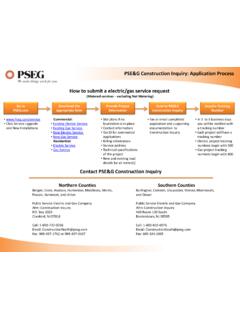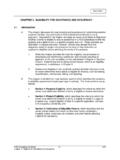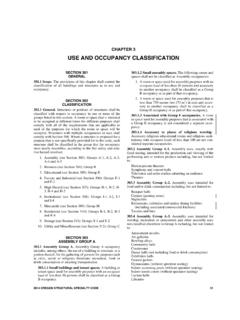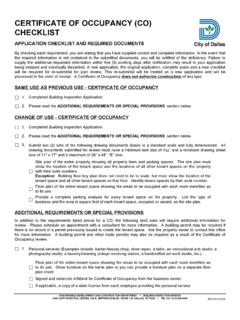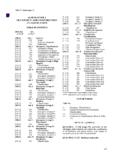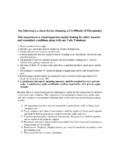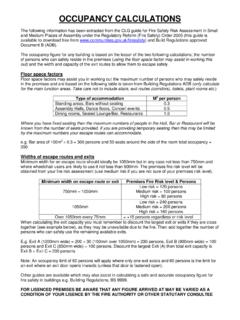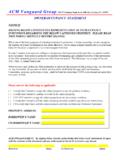Transcription of IBC 2009, NJ Ed. -Chapter 3, Use and Occupancy ...
1 IBC 2009, NJ Ed. -Chapter 3, Use and Occupancy ClassificationGroupA-1 Assembly A-2 Assembly A-3 Assembly A-4 Assembly A-5 Assembly group A EXCEPTIONS:B Business E EducationalGroup E EXCEPTIONS:DescriptionAssembly uses, usually with fixed seating, intended for the production and viewing of the performing arts or motion pictures. Examples: Motion picture theaters; Symphony and concert halls; Television and radio studios admitting an audience; uses intended for food and/or drink consumption. Examples: Banquet halls; Dance halls; Night clubs; Restaurants; Taverns and barsAssembly uses intended for worship, recreation or amusement and other assembly uses not classified elsewhere in group A. Examples: Amusement arcades; Art galleries; Bowling alleys; Places of religious worship; Community halls; Courtrooms; Exhibition halls; Funeral parlors; Gymnasiums (without spectator seating); Indoor swimming pools (without spectator seating); Indoor tennis courts (without spectator seating); Lecture halls; Libraries; Museums; Waiting areas in transportation terminals; Pool and billiard uses intended for viewing of indoor sporting events and activities with spectator seating.
2 Examples: Arenas; Skating rinks; Swimming pools; Tennis uses intended for participation in or viewing outdoor activities Examples: Amusement park structures; Bleachers; Grandstands; A building or tenant space used for assembly purposes with an occupant load of less than 50 persons shall be classified as a group B A room or space used for assembly purposes with an occupant load of less than 50 persons and accessory to another Occupancy shall be classified as a group B Occupancy or as part of that A room or space used for assembly purposes that is less than 750 square feet (70m2) in area and accessory to another Occupancy shall be classified as a group B Occupancy or as part of that Assembly areas that are accessory to group E occupancies are not considered separate occupancies except when applying the assembly Occupancy requirements of the barrier free subcode, 5 Accessory religious educational rooms and religious auditoriums with occupant loads of less than 100 are not considered separate of a building or structure, or a portion thereof, for office, professional or service-type transactions, including storage of records and accounts.
3 Examples: Airport traffic control towers; Animal hospitals, kennels and pounds; Banks; Barber and beauty shops; Car wash; Civic administration; Clinic outpatient; Dry cleaning and laundries: pick-up and delivery stations and self-service; Educational occupancies for students above the 12th grade; Electronic data processing; Laboratories testing and research; Motor vehicle showrooms; Post offices; Print shops; Professional services (architects, attorneys, dentists, physicians, engineers, etc.); Radio and television stations; Telephone exchanges; Training and skill development not within a school or academic of a building or structure, or a portion thereof, by six or more persons at any one time for educational purposes through the 12th grade, and day care services for more than five children older than 2 years of Religious educational rooms and religious auditoriums, which are accessory to places of religious worship having occupant loads of less than 100, shall be classified as A-3 1 IBC 2009, NJ Ed.
4 -Chapter 3, Use and Occupancy ClassificationGroupF-1 FactoryF-2 FactoryH-1 High HazardH-2 High HazardH-3 High HazardH-4 High HazardH-5 High HazardI-1 InstitutionalI-2 InstitutionalGroup I-2 EXCEPTIONS:I-3 InstitutionalDescriptionFactory industrial uses of a building or structure, or a portion thereof, for assembling, disassembling, fabricating, finishing, manufacturing, packaging, repair or processing operations of a moderate hazard Occupancy that are not classified as an F-2, group H hazardous or group S storage Occupancy . Examples: Aircraft; Appliances; Athletic equipment; Automobiles and other motor vehicles; Bakeries; Beverages; over 12-percent alcohol content; Bicycles; Boats; Brooms or brushes; Business machines; Cameras and photo equipment; Canvas or similar fabric; Carpets and rugs (includes cleaning); Clothing; Construction and agricultural machinery; Disinfectants; Dry cleaning and dyeing; Electric generation plants; Electronics; Engines (including rebuilding); Food processing; Furniture; Hemp products; Jute products; Laundries; Leather products; Machinery; Metals; Millwork (sash Motion pictures and television filming (without spectators); Musical instruments; Optical goods; Paper mills or products; Photographic film; Plastic products; Printing or publishing; Recreational vehicles; Refuse incineration; Shoes; Soaps and detergents; Textiles; Tobacco; Trailers; Upholstering; Wood; distillation; Woodworking (cabinet).)
5 Factory industrial uses that involve the fabrication or manufacturing of noncombustible materials which during finishing, packing or processing do not involve a significant fire hazard. Examples: Beverages; up to and including 12-percent alcohol content; Brick and masonry; Ceramic products; Foundries; Glass products; Gypsum; Ice; Metal products (fabrication and assembly).Detonation hazardUse of a building or structure, or a portion thereof, that involves the manufacturing, processing, generation or storage of materials that pose a deflagration hazard or a hazard from accelerated of a building or structure, or a portion thereof, that involves the manufacturing, processing, generation or storage of materials that readily support combustion or that pose a physical of a building or structure, or a portion thereof, that involves the manufacturing, processing, generation or storage of materials that are a health fabrication facilities and comparable research and development areas in which hazardous production materials (HPM)are of a building or structure, or a portion thereof, in which more than 5 persons are cared for on a 24-hour basis, who because of age, mental disability or other reasons, live in a supervised residential environment that provides personal care services.
6 The occupants are capable of slow evacuation in an emergency situation without physical assistance from staff. For the purposes of applying this provision, slow evacuation shall mean the movement of all occupants, residents, and staff to an exit in more than three minutes, but not more than thirteen minutes. Examples: Boarding houses; Halfway houses; group homes; Congregate care facilities; Social rehabilitation facilities; Alcohol and drug abuse centers; Convalescent of a building or structure, or portion thereof, for medical, surgical, psychiatric, nursing or custodial care on a 24-hour basis for more than five persons where evacuation is impractical. For the purposes of applying this provision, impractical evacuation shall mean the movement of all occupants, residents, and staff to an exit in more than 13 minutes. Examples: Assisted living facilities; Hospitals; Nursing homes (both intermediate care facilities and skilled nursing facilities); Mental hospitals; Detoxification facilities; Child care facility that provides care on a 24-hour basis to more than five children 2 1/2 years of age or A facility such as the above with five or fewer persons shall be classified as group and structures that are inhabited by more than five persons who are under restraint or security, and who are generally incapable of self-preservation due to security measures not under the occupants control.
7 Examples: Prisons; Jails; Reformatories; Detention centers; Correctional centers; Prerelease 2 IBC 2009, NJ Ed. -Chapter 3, Use and Occupancy ClassificationGroupI-4 InstitutionalGroup I-4 EXCEPTIONS:M MercantileR-1 ResidentialR-2 ResidentialR-3 ResidentialR-4 ResidentialDescriptionBuildings and structures occupied by persons of any age who receive custodial care for less than 24 hours by individuals other than parents or guardians, relatives by blood, marriage or adoption, and in a place other than the home of the person cared for. Examples: Adult care facility; Child care A facility such as above accessory to a dwelling unit and having five or fewer persons shall be classified as a group A facility where occupants are capable of prompt evacuation without physical assistance from the staff shall be classified as group A-3. For the purposes of applying this provision, prompt evacuation shall mean the movement of all occupants, residents, and staff to an exit in three minutes or of a building or structure or a portion thereof, for the display and sale of merchandise and involves stocks of goods, wares or merchandise incidental to such purposes and accessible to the public.
8 Examples: Department stores; Drug stores; Markets; Motor fuel-dispensing facilities; Retail or wholesale stores; Sales of a building or structure, or a portion thereof, for sleeping purposes when not classified as an Institutional group I. Residential occupancies containing sleeping units where the occupants are primarily transient (less than 30 days). Examples: Hotels (including motels) having transient Occupancy ( , where no more than fifteen percent of the residents occupy the residency for more than 90 days.); Rooming houses, with more than five residents, having transient Occupancy ; Vacation timeshare occupancies containing sleeping units or more than two dwelling units where the occupantsare primarily permanent in nature. Examples: Apartment houses; Convents; Dormitories; Fraternity and sorority houses; Hotels (non transient); Monasteries; Motels (non transient); Rooming houses with more than five residents, not having transient Occupancy ; Therapeutic residences with more than 16 one- and two-family dwellings greater than three stories in height, multiple single-family townhouses greater than three stories in height, attached two-family dwellings separated from adjacent units by firewalls, and other one and two-family dwellings that are outside the scope of the one and two-family dwelling subcode.
9 group R-3 includes: Single residential occupancies, accessory to a dwelling unit, having no more than five roomers or lodgers (Single occupancies, accessory to a dwelling unit, having more than five roomers or lodgers shall be classified as group R-2 or I-1, as appropriate.) Adult and child day care facilities, accessory to a dwelling unit, serving five or fewer persons of any age for less than 24 hours. group homes with five or fewer occupants, all of whom are capable of prompt self-evacuation. For the purpose of applying this requirement, prompt self-evacuation shall mean the movement to an exit in three minutes or less. Rooming houses with five or fewer residents. Therapeutic residences with five or fewer residences including more than five but not more than 16 occupants, excluding staff. A therapeutic residence is a residence for adults, each of whom is capable of prompt evacuation, and who live within a single dwelling unit for therapeutic purposes, without a resident landlord or operator, but with some government or private social service provider oversight.
10 For the purposes of applying this provision, prompt evacuation shall mean the movement of all occupants, residents, and staff to an exit in three minutes or 3 IBC 2009, NJ Ed. -Chapter 3, Use and Occupancy ClassificationGroupR-5 International Residential CodeS-1 StorageS-2 StorageU Utility & MiscellaneousDescriptionDetached one- and two-family dwellings not more than three stories in height with a separate means of egress and multiple single-family townhouses not more than three stories in height with a separate means of egress designed and constructed in accordance with the one- and two-family dwelling subcode. group R-5 includes: Single residential occupancies, accessory to a dwelling unit, having no more than five roomers or lodgers. Adult and child day care facilities, accessory to a dwelling unit, serving five or fewer persons of any age for less than 24 hours. group homes with five or fewer occupants, all of whom are capable of prompt self-evacuation.





